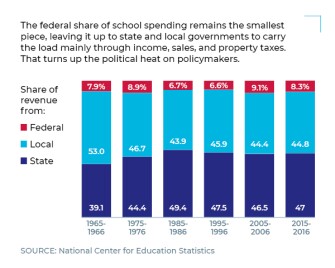America’s public school system today costs taxpayers over two-and-a-half times more that it did half a century ago—far outstripping changes in enrollment over that time. When federal, state, and local spending is taken together, it stands as one of government’s most-expensive endeavors.
There’s not just one culprit. That increase reflects an array of policy and priority shifts, changes in student demographics, state and federal mandates, built-in cost drivers affecting the workforce, and factors stemming from the economy at large.
Many will argue it’s still not enough, and that the money we are spending is not being distributed in a fair or effective way. Others make the case that massive governmental investment has failed to yield what it should have when weighed against student achievement.
It’s clear, however, that K-12 advocates, politicians, the courts, and others over the years have raised expectations of what schools should provide and to whom, and that it takes money to meet those demands. Here are some significant milestones.
How much does America spend on its public school system?

What are some policy, economic, and legal milestones for school spending and finance in the past half century?
1965 | President Lyndon B. Johnson signs the Elementary and Secondary Education Act, significantly expanding the federal role in K-12 education, with its signature program—Title I— aimed at helping districts cover the cost of educating disadvantaged students.
1973 | The U.S. Supreme Court rules in San Antonio ISD v. Rodriguez that the federal government is not constitutionally mandated to fund schools equitably.
1975 | Congress passes the Education for All Handicapped Children Act, requiring schools to identify all children with disabilities and provide them with a free and appropriate public education. It set federal funding commitments that have yet to be met.
1976 | California’s supreme court rules in Serrano v. Priest that the state is constitutionally required to distribute money “equitably” between districts. It serves as a template for lawsuits in other states and dramatically alters the way schools are funded, namely the infusion of state tax dollars to equalize spending distribution.
1982 | The U.S. Supreme Court rules in Plyler v. Doe that a state may not deny access to a basic public education to any child regardless of whether that child is in the country legally or not.
1983 | President Ronald Reagan’s National Commission on Excellence in Education releases “A Nation at Risk,” a report that deems America’s school system as failing and sets off reform efforts to improve academic outcomes.
1985 | New Jersey’s supreme court rules in Abbott v. Burke that the state is obligated to provide an “adequate” education for students to meet basic standards, prescribing how the state should fund schools in 31 school districts. It is one of the first in a series of state “adequacy” lawsuits that seek to dramatically increase the amount of money states spend on schools.
1989 | The nation’s governors commit during a national summit in Charlottesville, Va., to setting national education goals, upping the pressure for aggressive school reform efforts.
1994 | President Bill Clinton signs “Goals 2000,” which provides grants to states to create comprehensive reform plans to improve their schools.
2002 | President George W. Bush signs the No Child Left Behind Act, which, among other things, tasks the U.S. Department of Education to hold states accountable to a set of math and reading goals.
2007 | The Great Recession begins, leading to a tumble in income, sales, and property tax revenue for federal, state, and local governments, all of which school districts are heavily dependent on. More than 300,000 school personnel, mostly teachers, lose their jobs as a result.
2009 | President Barack Obama signs the American Recovery and Reinvestment Act, which sets aside $100 billion for schools including money to stabilize school budgets and funds for initiatives like Race to the Top.
2015 | President Barack Obama signs the Every Student Succeeds Act, which gives states additional flexibility over education policy, and requires that districts report school-by-school spending figures for the first time.
2018 | West Virginia teachers stage a first of a series of statewide strikes over stagnant pay, decrepit schools, and a massive teacher shortage, the first in a series of strikes across the country.
So, what is driving the costs?
Enrollment


Demographics

Operational Costs


Staffing


- Benefits

Who pays?












